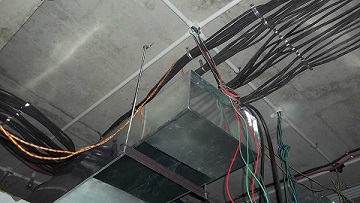Title Page
-
Client / Site
-
Location
-
Conducted on
-
Competent Person
-
Description of work
Electrical Equipment
-
When electrical equipment or lines are to be serviced, maintained, or adjusted, are necessary switches opened, locked out or tagged, whenever possible?
-
Are portable electrical tools and equipment grounded or of the double insulated type?
-
Are electrical appliances such as vacuum cleaners, polishers, vending machines, etc., grounded?
-
Do extension cords have a grounding conductor?
-
Are multiple plug adapters prohibited?
-
Are ground-fault circuit interrupters installed on each temporary 15 or 20 ampere, 120 volt alternating current (AC) circuit at locations where construction, demolition, modifications, alterations, or excavations are being performed?
-
Are all temporary circuits protected by suitable disconnecting switches or plug connectors at the junction with permanent wiring?
-
Are electrical installations not in hazardous dust or vapor areas?
-
Are exposed wiring and cords with frayed or deteriorated insulation repaired or replaced promptly?
-
REFERENCE: Electrical wires in good working condition
[This is an example of how you can use iAuditor to include best practice reference images in your templates to assist with inspections] -
Are flexible cords and cables free of splices or taps?
-
Are clamps or other securing means provided on flexible cords or cables at plugs, receptacles, tools, equipment, etc., and is the cord jacket securely held in place?
-
Are all cord, cable and raceway connections intact and secure?
-
In wet or damp locations, are electrical tools and equipment appropriate for the use or location or otherwise protected?
-
Is the location of electrical power lines and cables (overhead, underground, under floor, other side of walls, etc.) determined before digging, drilling, or similar work is begun?
-
Are metal measuring tapes, ropes, hand-lines or similar devices with metallic thread woven into the fabric prohibited where they could come in contact with energized parts of equipment or circuit conductors?
-
Is the use of metal ladders prohibited where the ladder or the person using the ladder could come in contact with energized parts of equipment, fixtures, or circuit conductors?
-
Are all disconnecting switches and circuit breakers labeled to indicate their use or equipment served?
-
Are disconnecting means always opened before fuses are replaced?
-
Do all interior wiring systems include provisions for grounding metal parts of electrical raceways, equipment and enclosures?
-
Are all electrical raceways and enclosures securely fastened in place?
-
Are all energized parts of electrical circuits and equipment guarded against accidental contact by approved cabinets or enclosures?
-
Is sufficient access and working space provided and maintained around all electrical equipment to permit ready and safe operations and maintenance?
-
Are all unused openings (including conduit knockouts) in electrical enclosures and fittings closed with appropriate covers, plugs, or plates?
-
Are electrical enclosures such as switches, receptacles, junction boxes, etc., provided with tight-fitting covers or plates?
-
Are disconnecting switches for electrical motors in excess of two horsepower able to open the circuit when the motor is stalled without exploding? (Switches must be horsepower rated equal to or in excess of the motor rating.)
-
Is low voltage protection provided in the control device of motors driving machines or equipment that could cause injury from inadvertent starting?
-
Is each motor disconnecting switch or circuit breaker located within sight of the motor control device?
-
Is each motor located within sight of its controller or is the controller disconnecting means able to be locked open or is a separate disconnecting means installed in the circuit within sight of the motor?
-
Is the controller for each motor that exceeds two horsepower rated equal to or above the rating of the motor it serves?
Employees
-
Are all employees required to report any obvious hazard to life or property in connection with electrical equipment or lines as soon as possible?
-
Are employees instructed to make preliminary inspections and/or appropriate tests to determine conditions before starting work on electrical equipment or lines?
-
Are employees who regularly work on or around energized electrical equipment or lines instructed in cardiopulmonary resuscitation (CPR)?
-
Are employees prohibited from working alone on energized lines or equipment over 600 volts?
Lockout Procedures
-
Are proper lock-out, tag-out and testing completed to ensure the voltage is off before performing maintenance on electrical equipment?
-
Are multiple locking devices used when more than one person works on a piece of equipment so workers can all apply their own lock?
-
If there is a question about the safe operation of an electrical tool or piece of equipment, is it removed from service, tagged and repaired by a qualified technician?
-
Are there written lock-out procedures provided for anyone performing lock-out procedures, including contractors?
-
Is proper lock-out and tag-out equipment available that has only one key per lock?
-
Are authorized workers trained in proper lock-out procedures when performing maintenance on electrical equipment?
-
Do supervisors ensure proper lock-out procedures are followed?
Overall Assessment and Recommendations
-
Overall assessment of the workplace
-
Enter recommendations here
Completion
-
Full Name and Signature of Inspector












